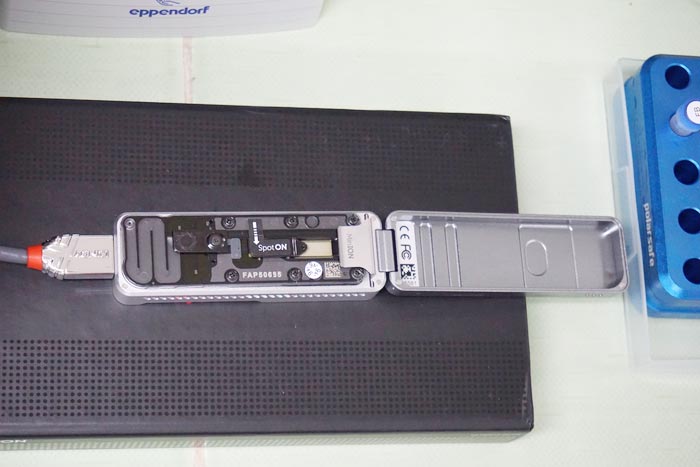Portable sequencing platform for SARS-CoV-2 monitoring to developing countries

Portable genomics device
Credit: Philippine Genome Center Mindanao
Genomic sequencing, rare in low-income countries, identifies and tracks variants of the virus that cause COVID-19. Variant tracking enables local governments and hospitals to make better-informed decisions to lower infections and deaths. Philippine Genome Center Mindanao (PGC Mindanao) has partnered with Accessible Genomics, a group of volunteering scientists from all around the world to implement a low start-up cost genomic sequencing platform for laboratories in developing countries. Ineke Knot from the Institute for Biodiversity and Ecosystem Dynamics (IBED) in Amsterdam has contributed with her knowledge of portable genomics devices.
According to Knot, PhD at the University of Amsterdam and one of the experts in the team, ‘genomic data can be used to identify and track variants of the virus, which helps scientists and government officials make better decisions about quarantine measures and vaccine administration.’ However, not all countries have access to the equipment, chemicals, and know-how to perform enough genomic sequencing to sufficiently track SARS-CoV-2 variants.
In May 2020, a group of students and scientists from across the world formed AccessibleGenomics.org in response to the pandemic. Most of them were from the field of portable genomics. The team then piloted SARS-CoV-2 sequencing in a representative lab from the Philippines which has complementary skills, facility, and experience on next generation sequencing, using recent advances in portable genomics technology. This partnership will serve as a learning experience for the local centre as it prepares to expand its omics facility and services in the region.
‘Like many developing countries, genomic sequencing machines in the Philippines were all housed in labs in the capital, Metro Manila. This was because sequencing machines used to cost more than a car and were as large as refrigerators’, says Ineke Knot. ‘Portable genomic sequencing was made possible in the past few years due to innovations like the MinION sequencer by Oxford Nanopore Technologies. This sequencing machine costs less than an iPhone and is as small as one too.’
Currently, plans are underway to fast-track the expansion of genomic surveillance in the main regions of the country through the Department of Health and Department of Science and Technology, as well as other efforts by both the government and private sectors in the country.
The team had a hard time raising funds from traditional sources as they do not represent an institution, but they managed to secure a microgrant from Just One Giant Lab — an open science platform. They also received a donation of the reagents needed for sequencing from New England Biolabs, Inc. Scientists from all over the world also volunteered their time and expertise to train the Filipino team that did the sequencing.
Upscaling
The next step of the project is to replicate the initiative in other countries and help labs in other developing countries to get started in variant identification. The new funding from JOGL.io and the donations from the crowdfunding campaign will be used to purchase more sequencers and their accompanying chemicals for these labs.
Knot: ‘We founded AccessibleGenomics.org on the belief that all communities should have access to SARS-CoV-2 variant identification.’
All latest news from the category: Medical Engineering
The development of medical equipment, products and technical procedures is characterized by high research and development costs in a variety of fields related to the study of human medicine.
innovations-report provides informative and stimulating reports and articles on topics ranging from imaging processes, cell and tissue techniques, optical techniques, implants, orthopedic aids, clinical and medical office equipment, dialysis systems and x-ray/radiation monitoring devices to endoscopy, ultrasound, surgical techniques, and dental materials.
Newest articles

Webb captures top of iconic horsehead nebula in unprecedented detail
NASA’s James Webb Space Telescope has captured the sharpest infrared images to date of a zoomed-in portion of one of the most distinctive objects in our skies, the Horsehead Nebula….

Cost-effective, high-capacity, and cyclable lithium-ion battery cathodes
Charge-recharge cycling of lithium-superrich iron oxide, a cost-effective and high-capacity cathode for new-generation lithium-ion batteries, can be greatly improved by doping with readily available mineral elements. The energy capacity and…

Novel genetic plant regeneration approach
…without the application of phytohormones. Researchers develop a novel plant regeneration approach by modulating the expression of genes that control plant cell differentiation. For ages now, plants have been the…





















